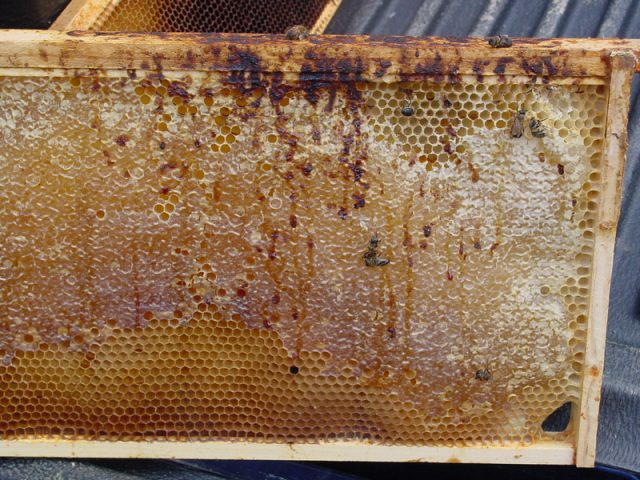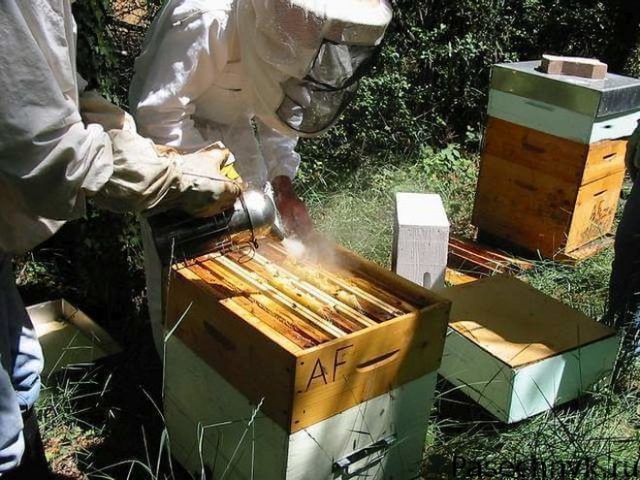Content
Nosematosis is a common occurrence among bee colonies, affecting all members of the bee colony: the fertile queen, worker insects, and drones. The perceived health problems of the bee colony can be provoked by an unsuccessful wintering. This phenomenon may be associated with the introduction of productive species into an environment to which beneficial insects are in no way adapted.
Possible causes of infection
This disease begins its development after the penetration of an intracellular parasite, which received the scientific name of microsporidium nozem, which is common in any climatic region. Parasites arise in the intestines, where they have a destructive effect on the sensitive mucous membrane. Pathogenic microorganisms emit destructive toxic substances that poison the bee.
Usually, families are infected in winter or early spring, in rare cases, the disease occurs in the fall. Disputes can be in a dormant state for a long period before the onset of favorable conditions.
The following conditions should be highlighted as provoking reasons for the spread of Nozema:
- Heat combined with high humidity.
- Insufficient feeding of the family.
- Increased amount of honeydew in the stern.
- Deficiency of life-giving carbohydrates.
- Early emergence of brood.
- Negative conditions during the wintering of a bee colony.
- Lack of cleanliness in the hives.
Symptoms and treatment of nosema disease in bees are directly related to insufficient care of the beekeeper for the apiary.
Factors affecting the development of the disease
Nosematosis, which destroys the health of bees, begins to actively develop, weaken the protective properties of bee colonies, if negative external conditions contribute to this, namely:
- cold hive;
- damp winter quarters;
- dirty bee nest.
As a result of the progression of insidious nosematosis, 65% of the existing bee colonies die, due to which the beekeeper suffers serious damage.
Signs of the disease of nosematosis in bees
The first signals of probable infection with nosematosis appear in working insects as early as 3-4 days after the penetration of destructive parasites. It is this period of time that represents the latent period.
The main signal for the beekeeper, indicating a destructive nosematosis, is profuse diarrhea of a watery structure in worker bees. Also, an enlarged belly may indicate a pathology, which is a consequence of dysfunction of the digestive processes, as a result of which protein starvation occurs.
Due to the death of the mammary glands in worker bees, the number of seasonal brood is reduced. In fertile queens, destructive parasites infect the ovaries, as a result, the number of laid eggs sharply decreases.
Diagnostic methods
If there is a suspicion of the development of nosematosis, then the proposed diagnosis is clarified. For this purpose, one individual is selected, the sharp part of the sting is removed from it with tweezers, the intestines are removed, and it is carefully examined.In infected insects, the intestines swell, the intestines acquire a light color, noticeably lose their firmness and elasticity.
Treatment of bees for nosematosis
Treatment of nosematosis of bees in the fall should be carried out in a timely manner, otherwise the beekeeper runs the risk of losing all broods. To begin with, the remaining individuals are sent on a cleaning flight.
Upon their return, they are placed in clean houses, and the dirty dwellings are thoroughly disinfected. The applied feed is replaced with fresh one, the infected queens are removed. The next step is to create the conditions necessary for a comfortable bee brood for the bees.
Preparations for nosema disease in bees
Treatment of nosematosis and prevention consists in the treatment with special drugs. For this purpose, the following effective formulations are used:
- common fumagillin;
- effective Nosemacid;
- Enteroseptol;
- Sulfadimezin.
How and when to give Nozemat to bees in the fall
For prophylactic purposes, effective Nosemate is used in the fall, strengthening the resistance of families to such infections. It is dissolved in sugar syrup, then fed to insects. In autumn, bee frames are dusted. The drug is used on the basis of the calculation of 5-6 g of powder per 1 bee frame. They are fed in an amount of 0.05 g per 1 frame.
Treatment of bees for nosematosis in the fall
Prevention of nosematosis in bees in autumn is a necessary procedure to protect bee colonies. After removing the shops in the hives, it is necessary to heal the bees with a natural alcoholic tincture of wormwood. This composition is made quite simply: 100 g of dried wormwood is poured into 1 liter of alcohol of 70% strength. Until cooked, the mixture is in a cool place for 10 days.
In order for the prevention of nosematosis in the fall to be successful, it is enough to use 10 ml of the resulting product per 1 liter of ordinary sugar syrup. Consumption is calculated on the basis of 1 liter per family. After the last pumping of honey, the beekeeper performs the autumn treatment of the bees from nosematosis with disinfectants in order to disinfect the hive. For this purpose, solutions of lye or store-bought "Whiteness", household "Mole" are suitable for cleaning blockages in pipes.
Treatment of nosematosis in bees with folk remedies
Autumn prevention of bees from nosematosis and treatment also involve the use of folk recipes. Experienced beekeepers heal families with the following simple remedies:
- Natural garlic tincture - 1 ml of the finished healing composition is added to 200-250 ml of syrup mass.
- A strong tincture of hot pepper - 40 ml of an effective composition leaves for 1 liter of syrup (for this, 50 g of dried pepper are steamed with 1 liter of boiling water).
- Sorrel tincture.
- Traditional composition of wormwood.
All these measures will help eliminate such an undesirable phenomenon as the spread of the Nosema parasite.
In addition to pharmaceutical plants, flowers of life-giving tansy are saved from insidious nosematosis. In the hive, the resulting product is placed between two gauze layers on the frame. The tool is kept for two days, after which it is removed with a break for 5 days, then the manipulation is repeated again.
Natural thyme is used to treat nests against Nozem parasites. Bee nests are also treated with a decoction based on it. For this purpose, 100 fresh leaves of the plant are mashed in a meat grinder, the resulting mass is placed between a gauze layer in a nesting frame. After 4 days, the clutch is repeated again.
For preventive purposes, coniferous flour is suitable, the aroma of which is not tolerated by harmful ticks, which are carriers of destructive diseases. After 12 hours, they crumble to the bottom of the bee hive, losing their natural ability to move further, the medicinal dust clogs the suction cups on their paws.To process a bee's nest, 60 g of pine flour is suitable.
Treatment of bees with wormwood for nosematosis
An effective folk remedy for combating the insidious nosematosis of bee colonies is the pharmacy wormwood. 500 g of dried raw materials are steamed in 10 liters of boiling water, after which the container is insulated and insisted for 2 days. The filtered product is thoroughly filtered and mixed with sugar syrup. For each liter, 100 ml of the finished composition is consumed. The mixed composition is dispensed in an amount of 100 g for each bee frame. Another prophylaxis of nosematosis of bees in autumn with wormwood reduces the infestation of colonies by up to 80%.
Also, the medicinal collection, created on the basis of pine buds and pharmaceutical wormwood, collected during the period of active flowering, has excellent effectiveness for strengthening the immunity of bee colonies. The collection includes:
- 10 liters of purified water;
- 900 g of wormwood collected during the flowering period;
- 50 g of pharmacy wormwood collected during the period of active growth of green mass;
- 50 g of fresh buds of natural coniferous pine.
Prevention measures
In order to prevent the spread of destructive parasites of insidious nosematosis in the bee population, each beekeeper must take certain preventive measures:
- The planned honeycomb change is carried out annually.
- The vomited honeycomb is subjected to a firebox.
- The frames are boiled in a solution of caustic soda after cutting the old sushi.
- During wintering, bees are fed with natural sugar, replacing 50% of the feed with this composition.
- Avoid the presence of unoccupied frames in the hives during the wintering period.
- Spread families that are resistant to various ailments, in the fall, connect the weak together.
- Create good airflow in the hive to prevent dampness.
- Clean and disinfect the bee hive annually in the spring.
- Honeydew honey is not suitable for feeding bees in winter.
- Create a comfortable environment for cleaning and disinfecting the hive.
- Do not hatch fertile queens in families infected with nozema.
- Change productive queens in suspicious colonies.
- The acquired families are placed in a certain quarantine.
- Maintain an optimal temperature of 4-5 ° C in winter and a humidity level not higher than 75-85%.
- Insulate the bee hive regularly.
Also, for preventive purposes, at the end of summer, Fumagilin is added to the traditional syrup, the consumption of the composition is 50 ml per 1 liter of natural syrup, 100 g of ready mixed syrup is used for the frame.
Conclusion
Nosematosis is an insidious phenomenon, the spread of which should not be allowed by any beekeeper in his hive. Fulfillment of simple sanitary requirements for keeping insects, rational preventive measures will help prevent this disease of bees. Regular application of methods beekeeping, aimed at improving the health of bee colonies, also helps to strengthen the immunity of insects. All these actions guarantee the health of the bees, the excellent productivity of the hive as a whole. Thorough treatment of bees from nosematosis in the fall is an action that every beekeeper should take on board. These measures will help increase the profitability of any apiary.











